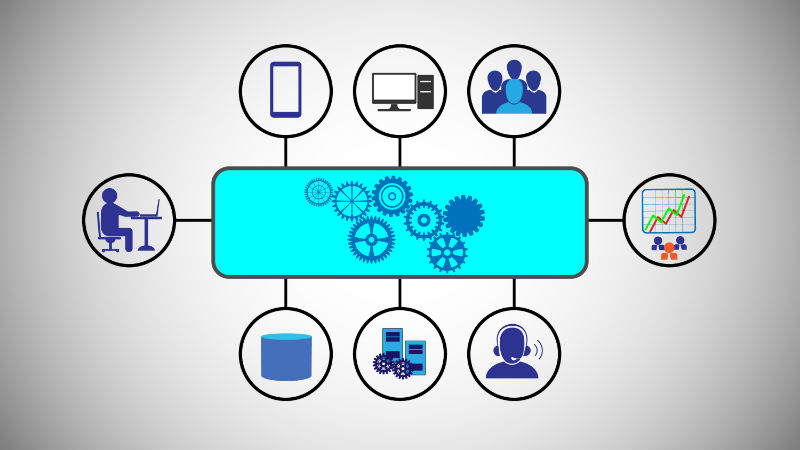Source – techtarget.com For the average worker, particularly the mobile worker, both the complexity of tools and the need for consultation with experts make it difficult to realize productivity improvement through analytics. However, microservices may hold the key to solving this problem. Since applications are being driven to microservice form by increased needs for context-sensitive work Read More
Category: Microservices

Source – itproportal.com In the world of microservices, the goal is to have a small piece of software that performs a well-defined set of tasks. Microservices are software applications that are self-contained. They are small, independently deployable modular services that run a unique process and communicate through a well-defined, lightweight mechanism to serve a specific goal. Read More

Source – opensource.com I struggled with writing the title for this post, and I worry that it comes across as clickbait. If you’ve come to read this because it looked like clickbait, then sorry.1 I hope you’ll stay anyway: there are lots of fascinating2 points and many3 footnotes. What I didn’t mean to suggest is that microservices cause security problems—though like any component, Read More

Source – ca.com Debunking misconceptions about microservice architecture helps us understand the business value of microservices. Much has been said recently about how digital “unicorns” owe much of their ability to deliver, iterate, pivot and scale to microservice architectures built using containers and APIs. This, in turn, has led to some backlash, with sceptics questioning the Read More

Source – techtarget.com What can go wrong when a business is migrating to microservices? Plenty. Microservices implementations often derail due to poor planning and lack of self-evaluation, said digital transformation expert Eric Roch. And that preparation is just stage one. Implementing microservices calls for new methods of rewarding DevOps and business teams and handling technical areas, like change Read More

Source – jaxenter.com Over the past decade, web-scale companies have shown a dramatic commitment to containers. In 2006, Google paved the way for this technological innovation, as engineers Paul Manage and Rohit Seith defined and implemented software containers. Almost a decade on, the tech giant released Kubernetes – an open source version of the solution that Read More

Source – techtarget.com Akshay Aggarwal: From going from a … monolithic design paradigm to a more distributed microservices design paradigm, the transition that we are seeing is driven by business efficiencies, economies of scale, as well as trying to make things simpler by reusing functionality across different applications. What that does to security is it simplifies Read More

Source – computerweekly.com More than just a technology buzzword, microservices are changing the way organisations develop software, according to the technology head honcho at SAP Hybris. Speaking to Computer Weekly on the sidelines of a recent company event, Moritz Zimmermann, chief technology officer of SAP Hybris, said unless organisations move from a “centralised command and control” way of Read More

Source – opensource.com Microservices have been a focus across the open source world for several years now. Although open source technologies such as Docker, Kubernetes, Prometheus, and Swarm make it easier than ever for organizations to adopt microservice architectures, getting your team on the same page about microservices remains a difficult challenge. For a profession that Read More

Source – theregister.co.uk Microservices aren’t a new concept to Java – their forerunner was Service Oriented Architectures (SOA), which could be constructed, among other means, with the assistance of Enterprise JavaBeans (EJBs). The fundamental concept behind microservices is applications should be broken down into small services that can be arbitrarily scaled independently of one another. Think Read More

Source – risingstack.com Monitoring gives us observability in our system and helps us to discover, understand, and address issues to minimize their impact on the business. It’s clear then, why you should aim for the best solutions out there; especially when you build a microservices architecture that has brought up new challenges in regards to observability. Read More

Source – news.sys-con.com IDC estimates 60% of worldwide enterprises are migrating existing applications to the cloud. With the promise of greater flexibility, a reduction in overhead, and the potential for significant cost savings, it’s a logical decision. But instead of performing a “lift and shift,” – simply moving an existing application to a cloud platform – many Read More

Source – digitalistmag.com Long gone are the days when customer service meant investing in a telephone system, hiring a team of contact center agents, and sitting by the phone waiting for the customer to call. The motto used to be, “If the customer is unhappy, they will call us.” Now it’s “What can we do today Read More

Source – ibm.com We’ve had a very good run for the last 20 years or so with distributed systems development in the enterprise, but time has started to show some of the downsides of traditional development styles. First of all, distributed systems have grown enormous – it’s very common to see corporate websites for retailing or Read More

Source – infoworld.com A few weeks ago, Nginx released its multilanguage microservices-friendly app server, but without Java support at launch. Now IBM has a beta build of its own microservices-friendly app server for Java applications: the open source Open Liberty, which implements IBM’s version of Java EE and MicroProfile microservices implementation. Open Liberty will provide a runtime supporting Java microservices Read More

Source – td.org Sales professionals have undoubtedly sat through many annual sales kick-off meetings, product launch training sessions, and classroom lectures wondering what they were trying to achieve. However, managers hope these events will impart the knowledge and skills of top-performing sales reps to less-experienced peers. They’re also trying to hone important skills like storytelling, customizing Read More

Source – techtarget.com he emergence of microservices boosts business agility, enabling rapid application development, deployment and modification. The challenge is baking in microservices security processes. Traditional security processes can’t secure microservices, because the latter work in and communicate between both internal and external environments, according to Amir Jerbi, CTO of Aqua Security, a container security platform Read More

Source – enterprisetech.com There’s lots of talk about “Digital Transformation” as if it were something new, as if the concept were in its infancy. But in truth, digital transformation has been around for a while, and it’s acting less like a newborn than an awkward teenager with growing pains, giving its parents plenty of trouble. The Read More

Source – rapidtvnews.com The company began its showcase of products at IBC 2017 with CEO Charlie Vogt assuring that contrary to some recent speculation the company was not the subject of acquisition. On the contrary, he said the firm’s investors had a golden opportunity to double down and take advantage of Imagine as began to ramp Read More

Source – theserverside.com There’s not much new in the world of malicious hackers raiding online software. Most attacks follow the same basic approach, and software developers are leaving their applications open to being blindsided in the most benign and boring of ways. Developing applications with microservices and containers may be a modern approach to software design, Read More

Source – enterprisersproject.com You can operate microservices without containers. However, microservices and containers are a dynamic duo, the IT equivalent of milk and cookies. “Microservices – single-function services built by small teams, independent from other functions, and communicating only through public interfaces – simply make a great match for containers,” as Red Hat technology evangelist Gordon Haff recently noted. “Microservices plus containers represent a shift Read More

Source – informationweek.com IT teams can salvage the value of legacy systems while pivoting to a new foundation offering better customer experiences. CIOs and their teams are routinely maintaining costly, long-running legacy systems that have gathered a large amount of data about purchases, services, and customer behavior over the years. Sure, they’re getting a bit creaky Read More

Source – techtarget.com A service registry sits between a client and server in a network and controls access between both of them. It is a critical part of the application stack and has a big impact on the end-user experience. With the growing use of microservices, the role of a service registry has become even more important Read More

Source – infoworld.com Nginx has introduced an application server for microservices environments. The open source Nginx Unit is designed for environments where developers use multiple languages in their deployments. It’s typical in microservices to use multiple languages and thus have multiple software stacks to manage and control, the company says. In its beta release this week, Nginx Unit Read More

Source – enterprisersproject.com Even Match.com could not have done a better job finding a mate for microservices. Microservices – single-function services built by small teams, independent from other functions, and communicating only through public interfaces – simply make a great match for containers. Microservices plus containers represent a shift to delivering applications through modular services that Read More

Source – zdnet.com At the core of any DevOps initiative is the judicious employment of containers and microservices, which dramatically speed up and simplifying the jobs of developers and operations teams alike. While many of the tried-and-true rules of IT management apply, containers and microservices also add new considerations, and new ways of doing things. To Read More

Source – jaxenter.com DevOps is a way of thinking; it’s an approach, not a specific set of tools. And that’s all well and good – but it only gives you half the picture. If we overstate DevOps as a philosophy or a methodology, then it becomes too easy to forget that the toolchain is everything Read More

Source – techtarget.com when it comes to working with microservices applications. Let’s look at three API design principles to follow when implementing APIs for microservices. There are three principal people who are responsible for the API design strategy: the business leader, the enterprise architect and the developer. An API design strategy begins with business leaders, Read More

Source – jaxenter.com Enterprises are increasingly turning to a microservice architecture for new applications to achieve greater agility and scalability, and the software industry is supporting them with development frameworks and tools for creating microservices. Yet, these don’t operate in a vacuum and often require an effective approach to integration. The challenge is that building integration Read More

Source – networkworld.com There’s no doubt that digital transformation (DX) is revolutionizing the way we do business, and cloud computing serves as a key cog in the DX machine. Cloud’s elasticity can indeed help digital businesses communicate more rapidly and increase innovation. But to extract full value from the cloud, companies must make sure that they Read More
